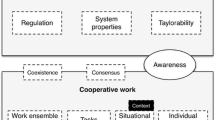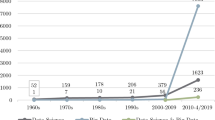Abstract
This paper uses a bibliometric analysis method to probe into the evolution of China’s science and technology policies from 1949 to 2010, and the roles of core government agencies in policy-making. We obtained 4,707 Chinese S&T policies from GDIS, a Chinese public policy database provided by Tsinghua University. Co-word analysis and network analysis were applied in mapping the topics of S&T policies and collaboration among the agencies, while citation analysis was applied to assess the influence of S&T policies. Findings include: first, the focus of Chinese S&T policies is mainly on applied research and industrialization, rather than basic research; second, more and more government agencies are involved in making S&T policies, but collaboration efforts are not significantly increasing; last but not least, the influence of different S&T policies is determined by the administrative ranking of the policy-making agencies responsible for drafting those policies.












Similar content being viewed by others
References
Callon, M., Courtial, J. P., & Laville, F. (1991). Co-word analysis as a tool for describing the network of interactions between basic and technological research: The case of polymer chemistry. Scientometrics, 22(1), 155–205.
Callon, M., Courtial, J. P., Turner, W. A., & Bauin, S. (1983). From translations to problematic networks: An introduction to co-word analysis. Social Science Information, 22(2), 191–235.
Coleman, T. F., & Moré, J. J. (1983). Estimation of sparse Jacobian matrices and graph coloring blems. SIAM Journal on Numerical Analysis, 20(1), 187–209.
Coulter, N., Monarch, I., & Konda, S. (1998). Software engineering as seen through its research literature: A study in co-word analysis. Journal of the American Society for Information Science, 49(13), 1206–1223.
Courtial, J. P. (1994). A coword analysis of scientometrics. Scientometrics, 31(3), 251–260.
Crouch, D., Irvine, J., & Martin, B. R. (1986). Bibliometric analysis for science policy: An evaluation of the United Kingdom’s research performance in ocean currents and protein crystallography. Scientometrics, 9(5), 239–267.
Debackere, K., & Glänzel, W. (2004). Using a bibliometric approach to support research policy making: The case of the Flemish BOF-key. Scientometrics, 59(2), 253–276.
Ding, Y., Chowdhury, G. G., & Foo, S. (2001). Bibliometric cartography of information retrieval research by using co-word analysis. Information Processing and Management, 37(6), 817–842.
Fang, X. (2010). Re-examining the reform of China’s science and technology system: A historical perspective. Journal of Science and Technology Policy in China, 1(1), 7–17.
Franklin, J. J., & Johnston, R. (1988). Co-citation bibliometric modeling as a tool for S&T policy and R&D management: Issues, applications, and developments (Vol. 325). Elsevier Science Publishers BV (North-Holland), Amsterdam.
Gao, Z., & Tisdell, C. (2004). China’s reformed science and technology system: an overview and assessment 1. Prometheus, 22(3), 311–331.
Hicks, D. (1987). Limitations of co-citation analysis as a tool for science policy. Social Studies of Science, 17(2), 295–316.
Hirsch, J. E. (2005). An index to quantify an individual’s scientific research output. Proceedings of the National Academy of Sciences of the United States of America, 102(46), 16569–16572.
Huang, C., Amorim, C., Spinoglio, M., Gouveia, B., & Medina, A. (2004). Organization, programme and structure: An analysis of the Chinese innovation policy framework. R&D Management, 34(4), 367–387.
Huang, C., Su, J., Xie, X., & Li, J. (2014). Basic research is overshadowed by applied research in China: a policy perspective. Scientometrics,. doi:10.1007/s11192-013-1199-x.
Lin, J. Y., & Yang, D. T. (2000). Food availability, entitlements and the Chinese famine of 1959–61. The Economic Journal, 110(460), 136–158.
Newman, M. E. J. (2010). Networks: An Introduction. Oxford: Oxford University Press.
OECD. (2002). Science and technology in China: Trends and policy challenges. Paris: OECD Science, Technology and Industry Outlook.
OECD. (2008). OECD reviews of innovation policy: China 2008. Paris: OECD Publishing.
Sociedade Portuguesa de Inovacao. (2002). InnoChina—policies, structures and training programmes to foster innovation in the science and technology sector in China. Retrieved July 12, 2013 from http://www.spi.pt/en/documents/studies.asp.
Scott, J. (2000). Social network analysis: A handbook. London: Sage Publications.
Smith, K., & Marinova, D. (2005). Use of bibliometric modelling for policy making. Mathematics and Computers in Simulation, 69(1), 177–187.
US Embassy Beijing. (2002). An evaluation of China’s science & technology system and its impact on the research community. A special report for the environment, science & technology section. Beijing: US Embassy Retrieved July 12, 2013 from http://www.usembassy-china.org.cn/sandt/ST-Report.doc.
Ventura, O. N., & Mombrú, A. W. (2006). Use of bibliometric information to assist research policy making. A comparison of publication and citation profiles of Full and Associate Professors at a School of Chemistry in Uruguay. Scientometrics, 69(2), 287–313.
Wang, Z. Y., Li, G., Li, C. Y., & Li, A. (2012). Research on the semantic-based co-word analysis. Scientometrics, 90(3), 855–875.
Yu, Q. Y. (1999). The implementation of China’s science and technology policy. Connecticut: Greenwood Publishing Group.
Zhao, S. X., Zhang, P. L., Li, J., Tan, A. M., & Ye, F. Y. (2014). Abstracting the core subnet of weighted networks based on link strengths. Journal of the Association for Information Science and Technology, 65(5), 984–994.
Zhong, X., & Yang, X. (2007). Science and technology policy reform and its impact on China’s national innovation system. Technology in Society, 29(3), 317–325.
Acknowledgments
We gratefully acknowledge financial support from the National Natural Science Foundation of China (Grant Numbers 71233005, 71173184, and 71203193). We also thank Ms. Ting Xia for helpful comments.
Author information
Authors and Affiliations
Corresponding author
Rights and permissions
About this article
Cite this article
Huang, C., Su, J., Xie, X. et al. A bibliometric study of China’s science and technology policies: 1949–2010. Scientometrics 102, 1521–1539 (2015). https://doi.org/10.1007/s11192-014-1406-4
Received:
Published:
Issue Date:
DOI: https://doi.org/10.1007/s11192-014-1406-4




